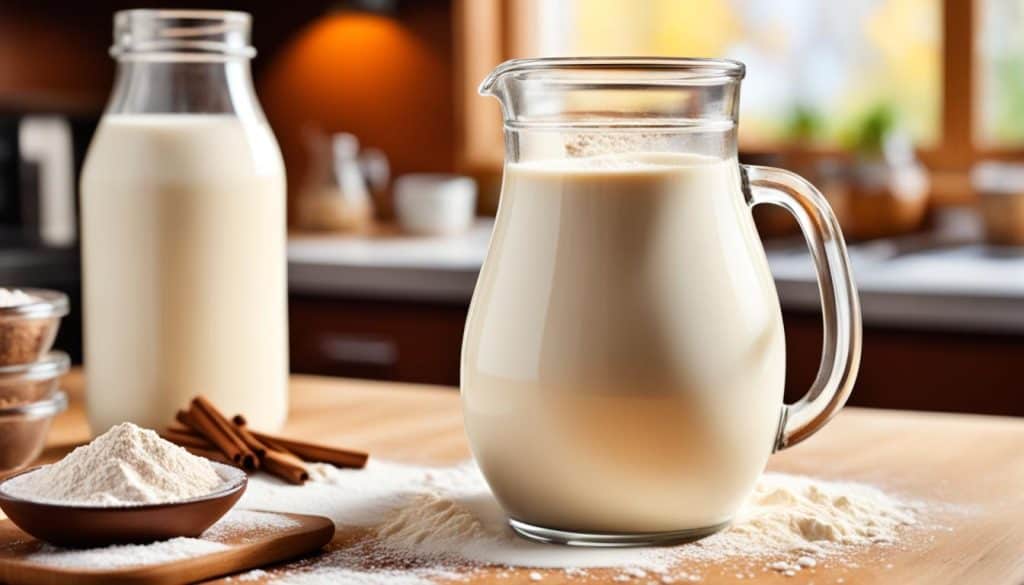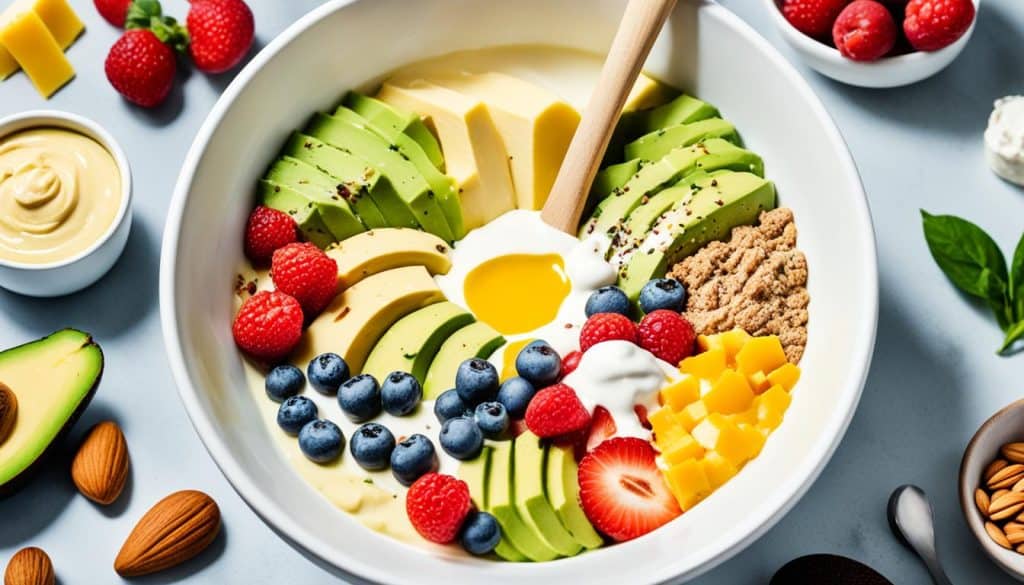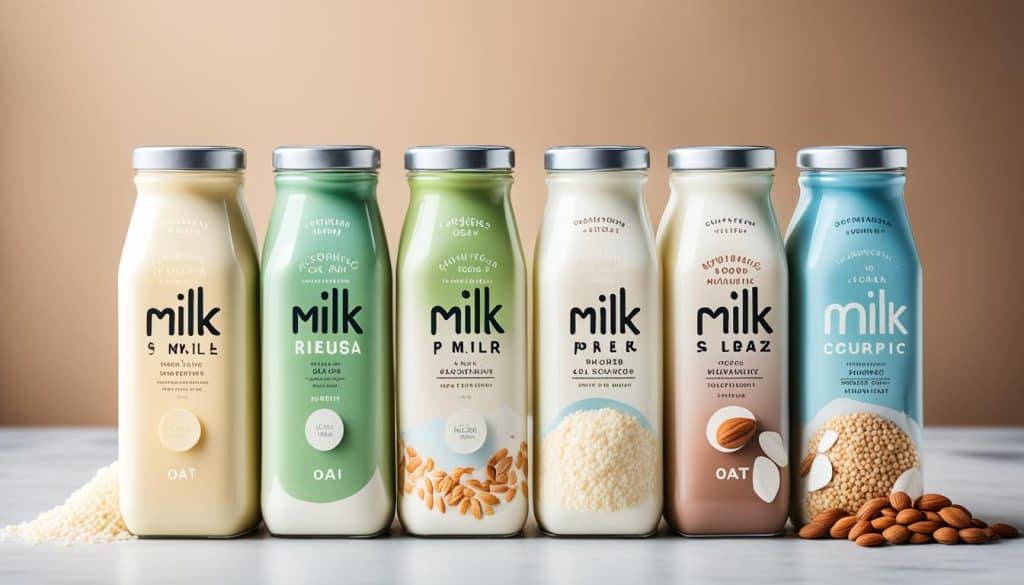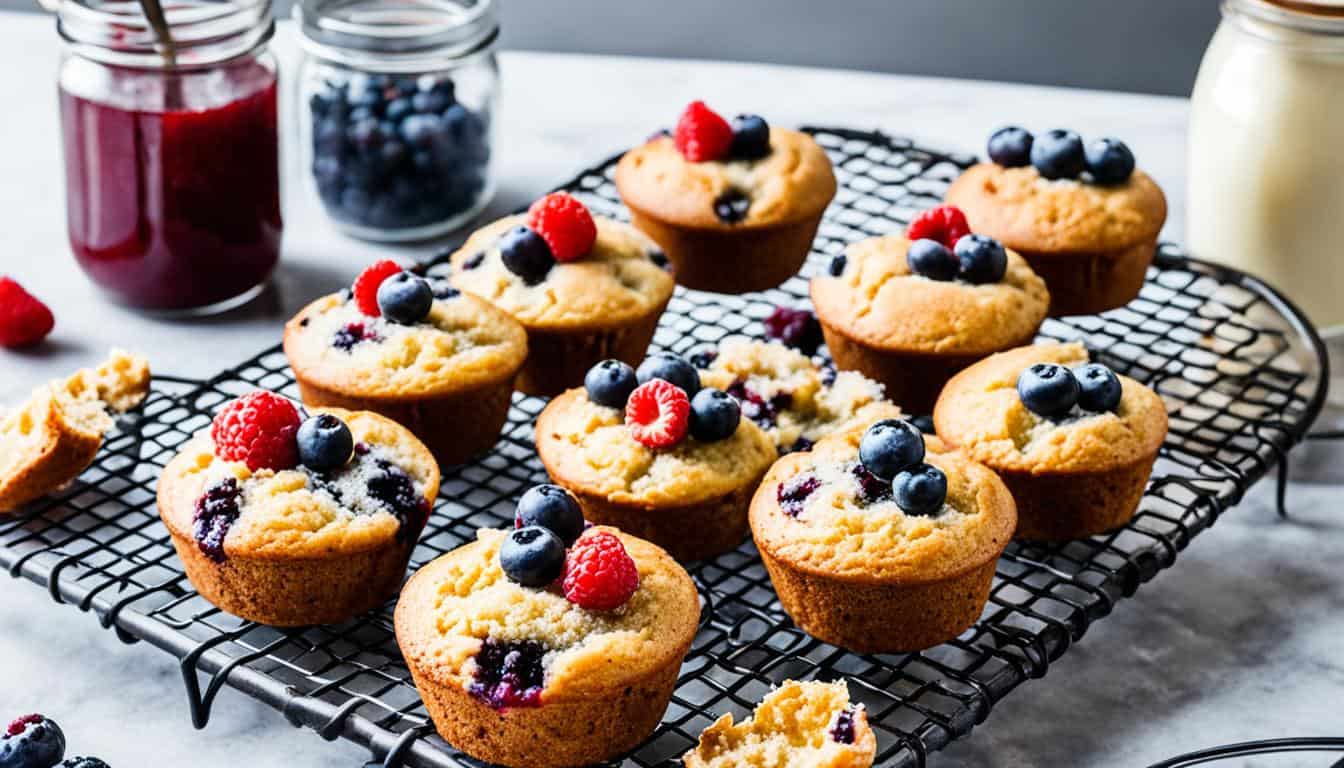Finding the right substitutes is key to baking without dairy. Whether you’re lactose intolerant or vegan, these tips will help you make tasty treats everyone can enjoy.
I have a story about my friend Sarah, who was lactose intolerant. She loved baking and wanted to make dairy-free desserts that tasted great. Sarah tried different ingredients and techniques, finding some key tips for baking without dairy.
Sarah’s go-to swap was using soy milk instead of regular milk. It tastes similar to cow’s milk and adds protein to baked goods. She used it in many recipes, from cakes to cookies.
For butter, Sarah used non-dairy butter alternatives like vegan butter, coconut oil, and olive oil. With the right ratios, her treats were as rich and tender as the traditional ones.
When recipes called for heavy cream, Sarah turned to coconut milk. It made her desserts creamy and rich. She loved it in caramel sauce and ganache.
Sarah also found many dairy-free alternatives for other dairy products. She used plant-based cream cheese and silken tofu to enjoy her favorite dishes without dairy.
As Sarah baked more, she learned some important tips. She started with recipes that didn’t include dairy to avoid mistakes. She also checked labels for hidden dairy ingredients.
To add moisture and flavor, Sarah used dairy-free yogurt and buttermilk alternatives. Spices like cinnamon and nutmeg, along with vanilla extract, made her desserts taste amazing.
With these tips, Sarah made many delicious dairy-free sweets. Her treats were so good, no one guessed they were dairy-free!
You don’t have to give up on taste and texture when baking without dairy. With the right substitutes and tips, you can make delicious treats that fit your diet.
Key Takeaways:
- Use soy milk as a substitute for regular milk in dairy-free baking.
- Replace butter with non-dairy alternatives like vegan butter, coconut oil, or olive oil.
- Coconut milk is a great replacement for heavy cream in dairy-free desserts.
- Explore a variety of dairy-free alternatives for other dairy products.
- Start with dairy-free baking recipes and pay attention to labels to avoid any hidden dairy ingredients.
The Best Milk Alternative for Baking: Soy Milk
Finding the right milk alternative for dairy-free baking is key. Soy milk stands out as the top choice for tasty results in your baked goods.
So, why is soy milk the best? It has a protein level similar to dairy milk. This means it gives your baked goods structure and makes them brown nicely. It also has the most protein among almond, oat, and coconut milk.
Regular milk has 8 grams of protein per cup, but soy milk has 7 grams. This makes your baked goods moist and full of flavor.
Soy milk also has a neutral taste and creamy texture. It works well in many recipes, like pancakes, bread, or cake. It won’t change the taste of your dish.
When fortified with vitamin B12, soy milk is a great source of calcium. This makes it perfect for those who want to meet their nutritional needs without giving up on taste or texture.
Using soy milk is easy. You can swap it for regular milk in most recipes without any changes. This makes baking without dairy easy and delicious.
So, choose soy milk for your next dairy-free baking project. It’s the secret ingredient that will take your desserts to the next level.

Substitutes for Butter in Dairy-Free Baking
Finding the right butter substitutes is key in dairy-free baking. Butter is high in fat and calories, which can increase cholesterol levels. If you want to lose weight or improve heart health, there are many alternatives that taste and act like butter but are dairy-free.

Vegan Butter
Vegan butter is a simple substitute for butter in dairy-free baking. It’s made with vegetable oils and has a similar texture and taste to butter. Brands like Earth Balance Vegan Buttery Sticks, Melt Organic Vegan Butter Sticks, and Blue Bonnet Lactose-Free Sticks mimic butter’s taste and function in recipes.
Plant-Based Oils
Plant-based oils like olive oil, canola oil, and coconut oil can replace butter in dairy-free baking. Use olive oil and canola oil in a 3/4:1 ratio, and coconut oil in a 1:1 ratio. These oils add moisture and fat, plus their own flavors to baked goods.
Fruit Purees
For a healthier option, try using fruit purees like applesauce as a butter substitute. They add moisture and sweetness, making your baked goods dairy-free and tasty.
Vegetable Shortening
Vegetable shortening is another rich butter substitute, used in a 1:1 ratio. Brands like Crisco All-Vegetable Shortening, Spectrum’s Organic All-Vegetable Shortening, and Nutiva Organic Vegan Shortening provide a butter-like texture without extra flavors.
The choice of butter substitute depends on what you like and your dietary needs. Whether you pick vegan butter, plant-based oils, fruit purees, or vegetable shortening, these options let you make delicious dairy-free baked goods without losing flavor or texture.
Dairy-Free Alternatives for Milk in Baking
Substituting milk in dairy-free baking is easy. There are many alternatives you can use in your recipes. If you’re lactose intolerant or just want non-dairy options, these substitutes will make your baked goods just as tasty as the traditional ones.
Lactose-Free Milk: Lactose-free milk is great for those who can’t digest lactose. It works just like regular milk in baking. So, you can still enjoy your favorite treats without any stomach issues.
Nut Milk: Nut milk, like almond or cashew milk, is a top pick for dairy-free baking. It gives your recipes a creamy texture and a nutty taste. Just remember to adjust the amounts based on the nut milk type you’re using.
Grain Milk: Grain milk is a versatile dairy-free choice. Oat and rice milks are great for many baked goods. They add richness and creaminess without extra fat. They’re especially good in bread puddings and banana breads.

Homemade Dairy-Free Milks: Making your own dairy-free milks is simple. Just soak nuts or seeds, drain, rinse, and blend them with water. This lets you control the flavor and consistency of your milk.
With these substitutes, you can make delicious dairy-free baked goods. Try different options and enjoy the taste and benefits of non-dairy milk in your favorite treats.
Dairy-Free Substitute for Heavy Cream
Heavy cream makes many baked goods and desserts rich and creamy. If you’re looking for a dairy-free option, there are great substitutes. These options will keep your recipes tasty and dairy-free:
Silk Heavy Whipping Cream
Silk Heavy Whipping Cream is a good store-bought choice. Use it as a 1:1 substitute for heavy cream in recipes. It’s creamy and tastes neutral, making it a perfect swap without losing flavor or texture.
Coconut Cream
Coconut cream is another great dairy-free heavy cream substitute. It’s thick and sweet, making it a perfect 1:1 replacement in recipes. Its rich taste adds a tropical flavor to your desserts.
Soy Milk and Olive Oil Cream
Make your own dairy-free heavy cream with soy milk and olive oil. Mix 2 parts soy milk with 1 part olive oil. For every 1 cup of heavy cream, use 2/3 cup soy milk and 1/3 cup olive oil. This mix creates a creamy and tasty substitute for many recipes.
Vegan Soy Heavy Cream
Vegan soy heavy cream is another top choice. Blend 1 cup of silken tofu with about 1/4 cup of soy milk for every 1 cup of heavy cream. This blend makes a creamy, dairy-free substitute for baking and cooking, using a 1:1 ratio.
Non-Dairy Milk and Cornstarch
For a simple substitute, mix non-dairy milk and cornstarch in a 1:1 ratio. Use 1 cup of non-dairy milk with 2 tablespoons of cornstarch to replace 1 cup of heavy cream. This mix creates a thick, creamy texture for many recipes.
When trying dairy-free baking, remember each substitute has its own taste and texture. Try different options to find the best one for your recipe. The article provides a chart that outlines the pros and cons of various substitutes, including Silk Heavy Whipping Cream, Coconut Cream, Soy Milk and Olive Oil Cream, Vegan Soy Heavy Cream, Non-Dairy Milk and Cornstarch, Vegan Cashew Cream, and White Bean Cream.
Using these dairy-free substitutes lets you enjoy creamy desserts without dairy. So, try these alternatives in your favorite recipes for delicious dairy-free treats!
Dairy-Free Alternatives for Other Dairy Products
There are many dairy products you can swap out in baking without dairy. With more people wanting dairy-free options, there are now many non-dairy choices for cheese, condensed milk, and cream cheese.
Non-Dairy Cheese
For recipes needing cheese, there are several dairy-free choices. Vegan cheese works well, with brands like Chao Creamery offering products that melt and taste like real cheese. Or, you can make your own by mixing nutritional yeast and nuts for a similar taste.
Alternatives for Condensed Milk
Condensed milk adds sweetness and creaminess to baking. Coconut milk is a good dairy-free choice because it’s thick and sweet. You can also use homemade cashew cream for a creamy texture in your baked goods.
Dairy-Free Cream Cheese
Cream cheese is key in many recipes, and there are dairy-free versions available. Plant-based cream cheeses come from nut milks like almond or cashew milk and have a tangy taste. Trying different brands can help you find the best one for your recipes.
Using these dairy-free substitutes lets you make treats for a wider audience. They’re great for those who are lactose intolerant, vegan, or just want to eat less dairy. These options taste good and don’t lose out on flavor or texture.
Conclusion
With these dairy-free baking tips, you can make delicious treats without missing out on taste or texture. Use substitutes like soy milk, non-dairy butter, and coconut milk for a dairy-free baking experience. Try different alternatives for milk, butter, and other dairy items to find what works best in your recipes.
For cream or half-and-half substitutes, mix 60% cream with 40% water. Or, use a 50-50 mix of evaporated milk and water. If a recipe calls for a little milk, like in pie crusts or cookie dough, water works just fine. For more milk, add a tablespoon of melted butter per cup of water to keep the fat content right.
Use nut milks like almond or pistachio milk as a direct swap for regular milk in most recipes. Choose unsweetened nut milks to keep your baked goods tasting great. Also, you can swap soy milk for milk in recipes for similar results. Just make sure to pick unsweetened soy milk to avoid too much sweetness.
Dairy-free baking is great for those who can’t have dairy. Plant-based milks add moisture and texture, while non-dairy butters and margarines can replace traditional butter. Try using applesauce, mashed bananas, or flaxseed meal as egg substitutes. Add flavorful ingredients and techniques to make up for the lack of dairy taste.
Always check labels for hidden dairy in packaged foods, especially if you have lactose intolerance or dairy allergies. Getting medical advice is key for the right diagnosis and treatment of dairy issues. With the right ingredients, techniques, and tools like non-stick sheets and blenders, you’re ready to start your dairy-free baking adventure.


